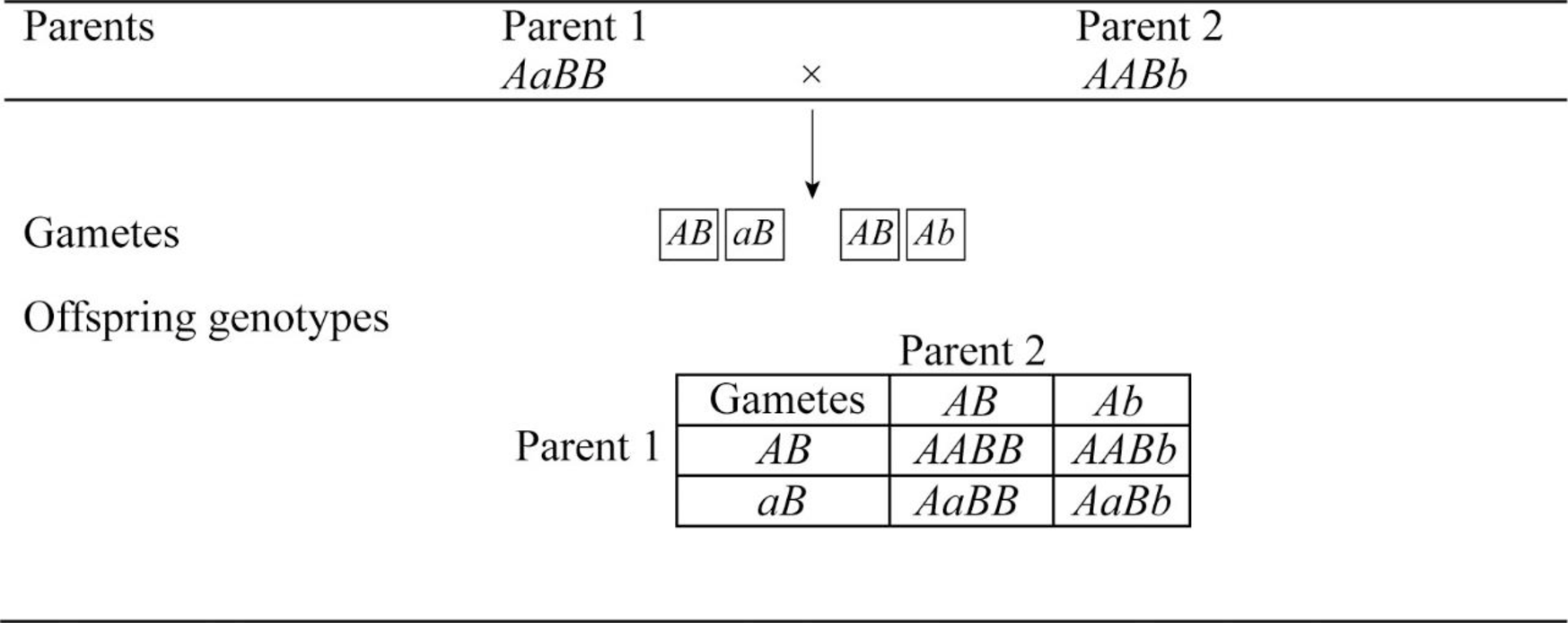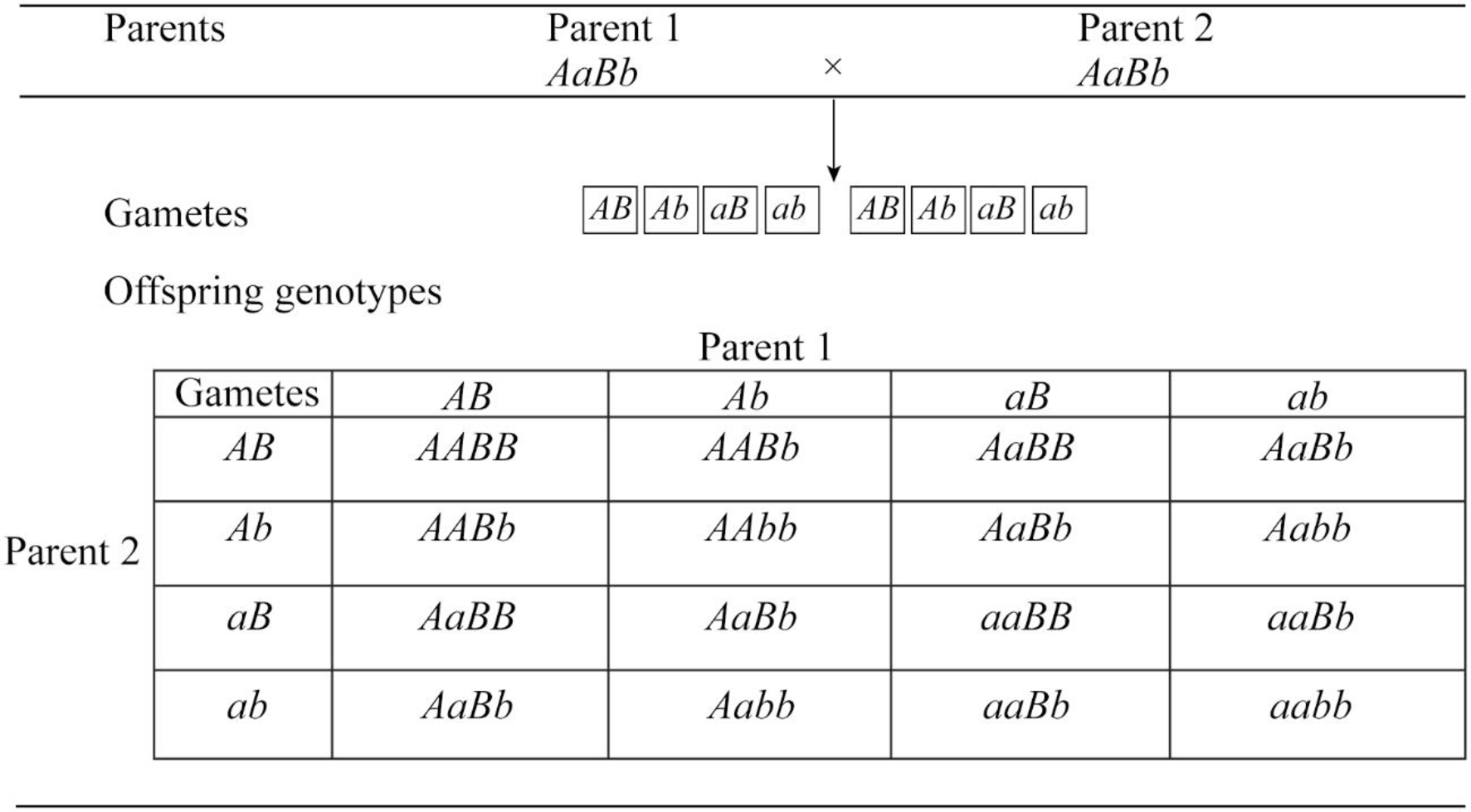
Concept explainers
Still referring to Problem 1, what will be the possible genotypes of offspring from the following matings? With what frequency will each genotype show up?
- a. AABB × aaBB
- b. AaBB × AABb
- c. AaBb × aabb
- d. AaBb × AaBb
a.
To predict: The predicted genotype frequencies among the offspring for the mating AABB × aaBB.
Introduction: The law of independent assortment and law of segregation are the laws proposed by Gregor Johann Mendel, a geneticist. Mendel proposed the law of independent assortment based on the results of monohybrid cross that “two alleles at any locus tend to separate from each other during meiosis, so they end up in different gametes”. Mendel proposed the law of independent assortment based on the results of dihybrid cross that “alleles at one locus tend to assort into gametes independently of alleles at other loci”. The number of possible allele combination for the given genotype is given by the formula 2n where “n” is the number of heterozygous alleles that are present.
Explanation of Solution
A monohybrid cross is constructed with Punnett square for the parents having the genotype AABB and aaBB.

All the offspring have the same genotype AaBB. Therefore, there is no genotype frequency.
b.
To predict: The predicted genotype frequencies among the offspring for the mating AaBB × AABb.
Introduction: The law of independent assortment and law of segregation are the laws proposed by Gregor Johann Mendel, a geneticist. Mendel proposed the law of independent assortment based on the results of monohybrid cross that “two alleles at any locus tend to separate from each other during meiosis, so they end up in different gametes”. Mendel proposed the law of independent assortment based on the results of dihybrid cross that “alleles at one locus tend to assort into gametes independently of alleles at other loci”. The number of possible allele combination for the given genotype is given by the formula 2n where “n” is the number of heterozygous alleles that are present.
Explanation of Solution
A monohybrid cross is constructed with Punnett square for the parents having the genotype AaBB and AABb.

The following is the frequency of genotypes.
Total number of possible genotypes = 4.
AABB=
AABb=
AaBB=
AaBb =
The frequency of all four genotypes is 25%.
c.
To predict: The predicted genotype frequencies among the offspring for the mating AaBb × aabb.
Introduction: The law of independent assortment and law of segregation are the laws proposed by Gregor Johann Mendel, a geneticist. Mendel proposed the law of independent assortment based on the results of monohybrid cross that “two alleles at any locus tend to separate from each other during meiosis, so they end up in different gametes”. Mendel proposed the law of independent assortment based on the results of dihybrid cross that “alleles at one locus tend to assort into gametes independently of alleles at other loci”. The number of possible allele combination for the given genotype is given by the formula 2n where “n” is the number of heterozygous alleles that are present.
Explanation of Solution
A monohybrid cross is constructed with Punnett square for the parents having the genotype AaBb and aabb

The following is the frequency of genotypes.
Total number of possible genotypes = 4.
AABB=
aaBB=
Aabb=
aabb =
The frequency of all four genotypes is 25%.
d.
To predict: The predicted genotype frequencies among the offspring for the mating AaBb × AaBb.
Introduction: The law of independent assortment and law of segregation are the laws proposed by Gregor Johann Mendel, a geneticist. Mendel proposed the law of independent assortment based on the results of monohybrid cross that “two alleles at any locus tend to separate from each other during meiosis, so they end up in different gametes”. Mendel proposed the law of independent assortment based on the results of dihybrid cross that “alleles at one locus tend to assort into gametes independently of alleles at other loci”. The number of possible allele combination for the given genotype is given by the formula 2n where “n” is the number of heterozygous alleles that are present.
Explanation of Solution
A monohybrid cross is constructed with Punnett square for the parents having the genotype AaBb and AaBb.

The following is the frequency of genotypes.
Total number of possible genotypes = 16.
AABB=
AABb=
AaBB=
AaBb=
AAbb=
Aabb=
aaBB=
aaBb=
aabb=
The frequency of genotypes AABB, aaBB , AAbb and aabb is 6.25%.
The frequency of genotypes AaBB, AABb, aaBb and Aabb is 12.5%.
The frequency of genotypes AaBb is 25%.
Want to see more full solutions like this?
Chapter 19 Solutions
Human Biology (MindTap Course List)
- The F1 flies described in question 1 were mated with brown-eyed flies from a true-breeding line. What phenotypes would you expect the offspring to have? (a) all with red eyes (b) all with brown eyes (c) half with red eyes and half with brown eyes (d) red-eyed females and brown-eyed males (e) brown-eyed females and red-eyed malesarrow_forwardln a population of turtles, there are yellow-green shells and green shells. The yellow shells are caused by a homozygous recessive gene and the green shells are caused by the dominant gene. Given the following data:AA = 340Aa = 270aa = 120 a) Calculate p and q. b) Use a chi square test to determine if these alleles are in Hardy-Weinberg equilibrium. Submit your answer as a pdf or doc file. Show your workarrow_forwardA. Part 1: F1 Generation Yellow Sampaguita- Homozygous recessive (cc) White Sampaguita- Homozygous dominant (CC) a. With the given sampaguita flowers, you will be crossing these two samples and identify the offspring using a punnet square. Indicate the ratio between each offspring B. Part 2: F2 generation a. With the results you have from Part 1 and using a punnet square, what are the offspring of your heterozygous parents to identify the F2 generation. Indicate the ratio between each offspring. Note: Please provide the punnet square and a detailed explanationarrow_forward
- Cardigan Corgi tail length is determined by 5 genes. The genotype DDEEFFGGHH produces a tail length of 44cm, while the genotype ddeeffgghh produces a tail length of 4cm. a) Each additive allele adds how many centimeters to the tail length? b) Predict the tail length for the following genotype: DDEEFfGgHh Group of answer choices 8cm, 56cm 4cm, 12cm 8cm, 24cm 4cm, 32cmarrow_forwardYou have determined that the gene order for three linked genes being studied is A B C. The number of recombinants resulting from crossover between genes A and BC are 44 and 48, respectively, while the double-crossover progeny total 4 and 6. What is the recombination frequency between genes A and B if the total progeny from the cross is 1000? Show all of your work.arrow_forwardCan you please help me solve and explain this question: Consider two genes A and B. If there are on average 8.5 crossovers taking place between A and B. what is the map distance between A and B? (map units)arrow_forward
- In a certain plant, leaf size is determined by fourgenes whose alleles assort independently and actadditively. Thus, alleles A, B, C, and D each add4 cm to leaf length and alleles A′, B′, C′, andD′ each add 2 cm to leaf length. Therefore,an AA BB CC DD plant has leaves 32 cm longand an A′A′ B′B′ C′C′ D′D′ plant has leaves16 cm long.a. If true-breeding plants with leaves 32 cm longare crossed to true-breeding plants with leaves16 cm long, the F1 will have leaves 24 cm longand the genotype AA′ BB′ CC′ DD′. Listall possible leaf lengths and their expectedfrequencies in the F2 generation produced fromthese F1 plants.arrow_forwardCystic fibrosis (CF) is a recessive autosomal disorder. In certain populations of Northern European descent, the number of people born with this disorder is about 1 in 2500. Assuming Hardy- Weinberg equilibrium for this trait: A. What are the frequencies for the normal and CF alleles? B. What are the genotype frequencies of homozygous normal, heterozygous, and homozygous affected individuals? C. Assuming random mating, what is the probability that two phenotypically unaffected heterozygous carriers will choose each other as mates?arrow_forwardScenario A In goats, black fur is dominant to red fur. The gene for this trait can be described as Bb (if you forgot why this is so, go back and reread the background information at the beginning of this exercise). A homozygous black female goat (nanny) is crossed with a heterozygous male (billy). What is the genotype of the billy? What is the phenotype of the billy?arrow_forward
- Suppose there is an autosomal locus of 2 alleles, A1 and A2, with probabilities (frequencies) p1 and p2, and the genotype probabilities (frequencies) are P(A1A1) = p1*p1, P(A1A2) = 2*p1*p2, and P(A2A2) = p2*p2, respectively. Prove the Hardy-Weinberg Law, i.e., after one generation of random mating, the genotype probabilities (frequencies) in the offspring are also P(A1A1) = p1*p1, P(A1A2) = 2*p1*p2, and P(A2A2) = p2*p2. Hint: List all possible combinations of random mating. Then list the probabilities of the resulting genotype probabilities (frequencies) in the offspring. Combine the probabilities of random mating and resulting genotype probabilities (frequencies) in the offspring.arrow_forwardRefer to problem 2. Determine the predicted genotype frequencies among the offspring of the following crosses: a. AABB × aaBB c. AaBb × aabb b. AaBB × AABb d. AaBb × AaBbarrow_forwardGo back to Problem 1, and assume you now study a third gene having alleles C and c. For each genotype listed, what type(s) of gametes can be produced? a. AABBCC b. AaBBcc c. AaBBCc d. AaBbCcarrow_forward
 Human Biology (MindTap Course List)BiologyISBN:9781305112100Author:Cecie Starr, Beverly McMillanPublisher:Cengage Learning
Human Biology (MindTap Course List)BiologyISBN:9781305112100Author:Cecie Starr, Beverly McMillanPublisher:Cengage Learning Biology (MindTap Course List)BiologyISBN:9781337392938Author:Eldra Solomon, Charles Martin, Diana W. Martin, Linda R. BergPublisher:Cengage Learning
Biology (MindTap Course List)BiologyISBN:9781337392938Author:Eldra Solomon, Charles Martin, Diana W. Martin, Linda R. BergPublisher:Cengage Learning

